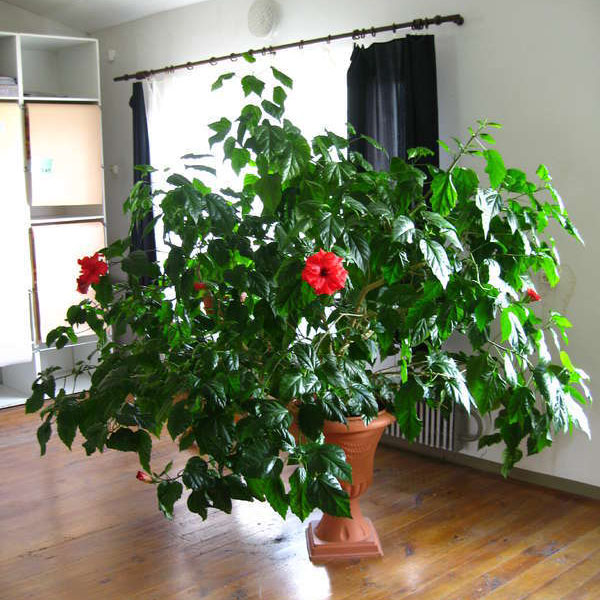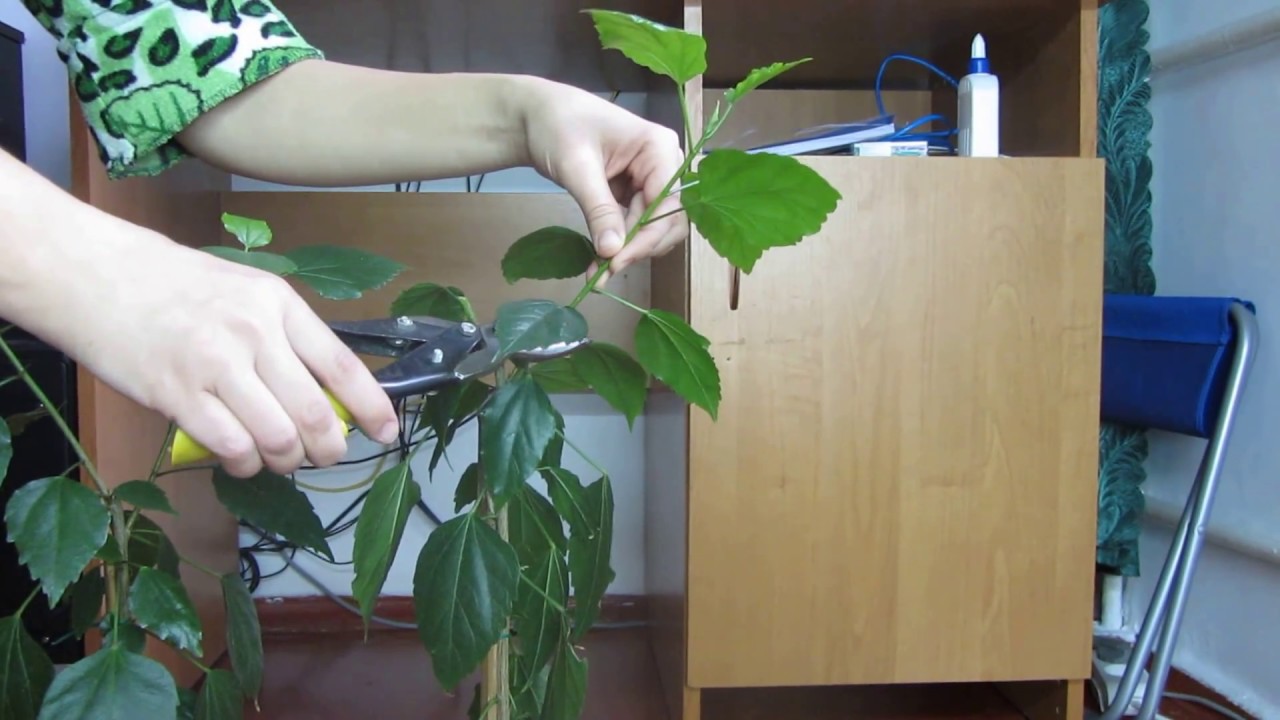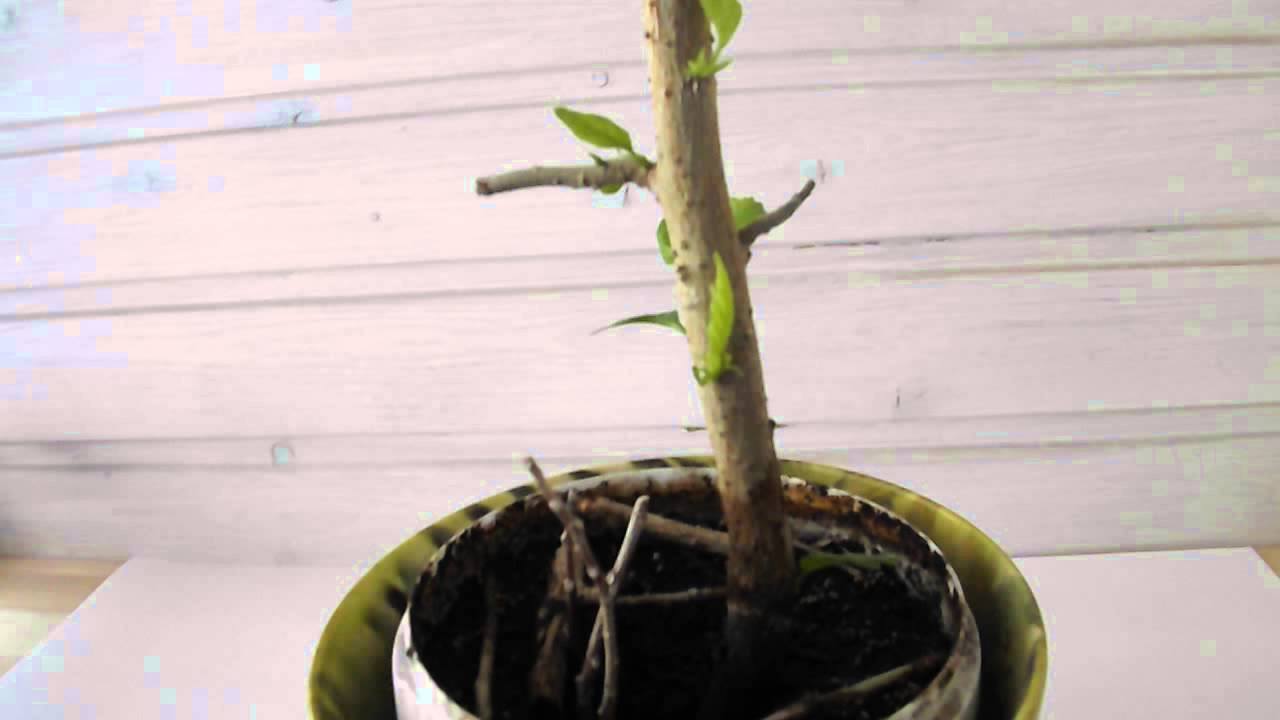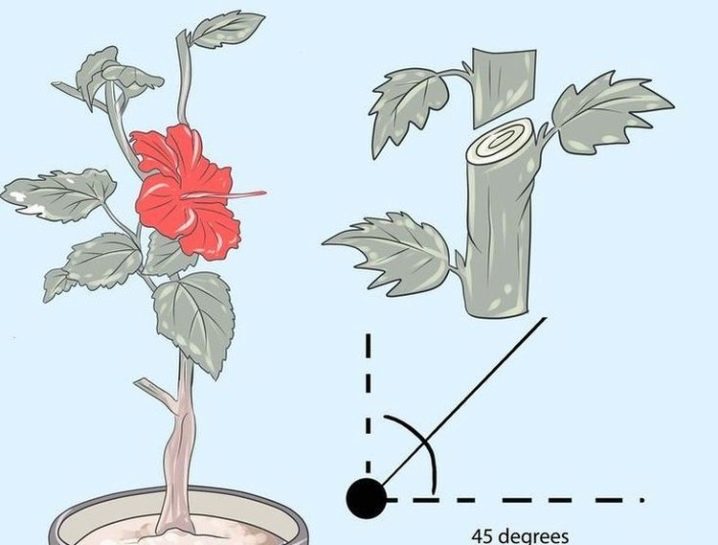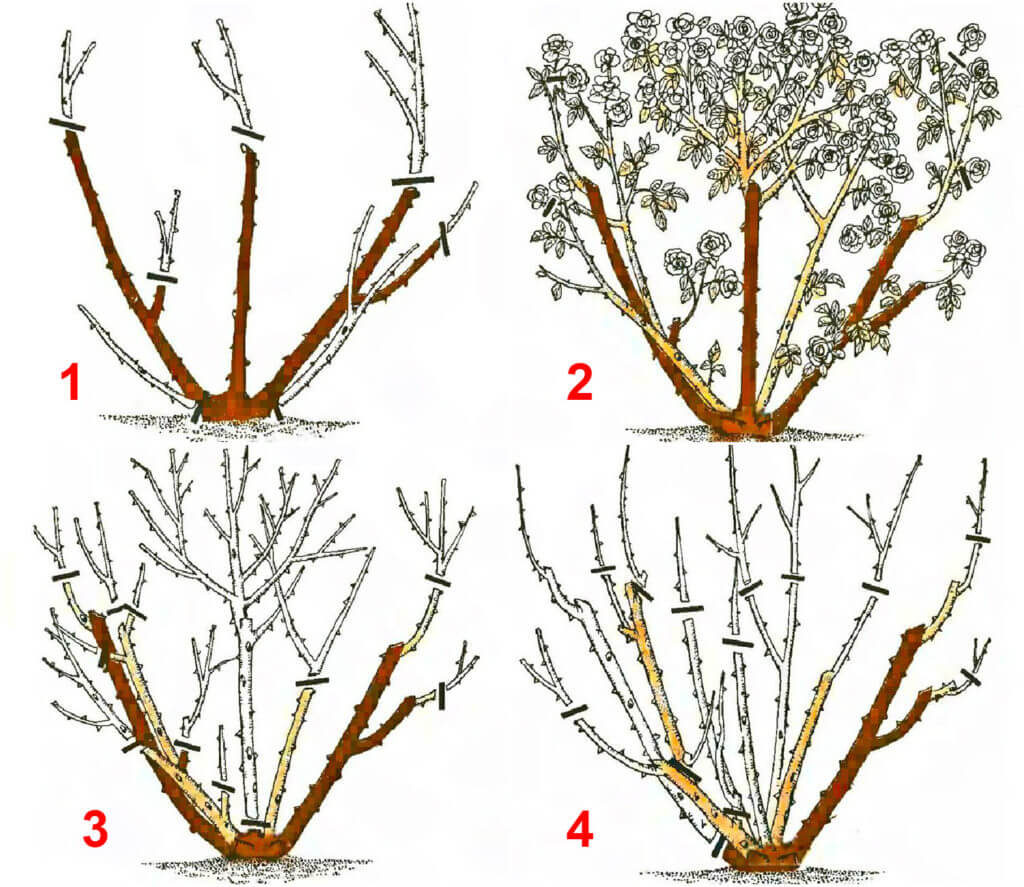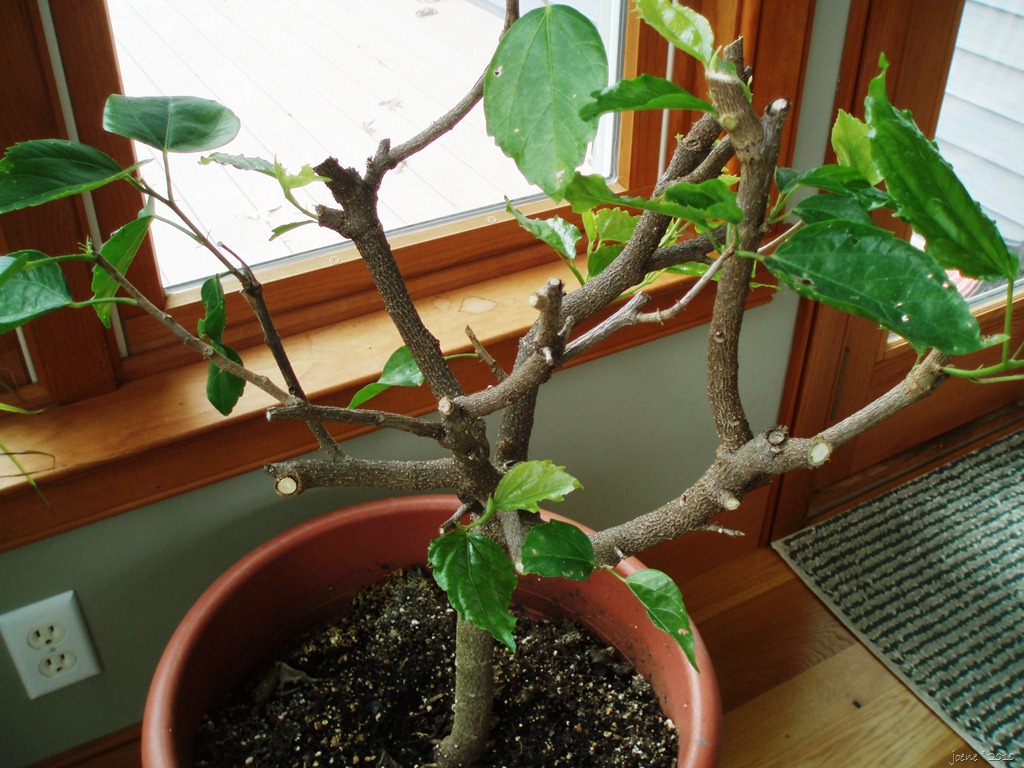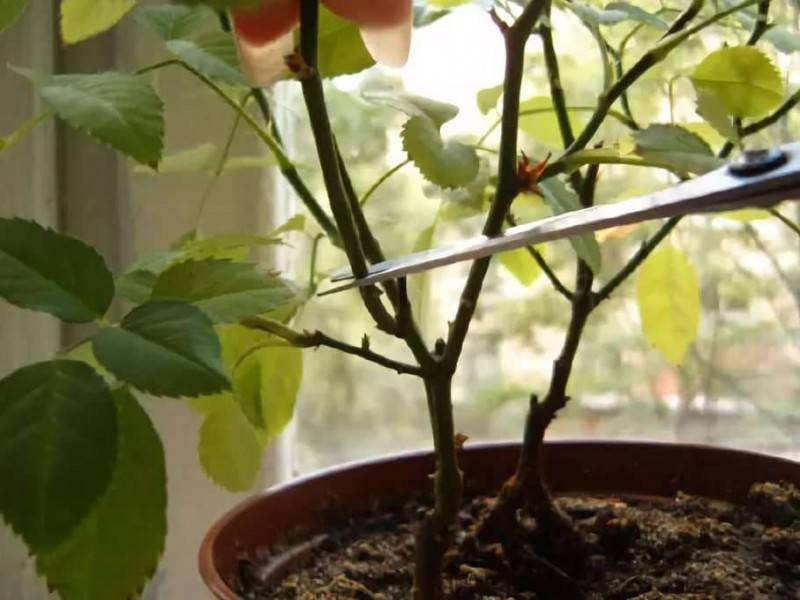Planting, transplanting, choosing a place for a Chinese rose
The first thing you should know is that a Chinese rose needs bright sunlight! Place your beauty near the window itself so that the sun's rays can easily penetrate the leaves of the plant. I will reveal a secret - the tree will not like the shadow, and it will refuse to please you with exquisite flowers. In summer, you can even send hibiscus outside, the fresh air will help bloom.
You need to plant a Chinese rose in the ground, which you can perfectly prepare yourself. For him you will need:
- 2 liters of turf soil;
- 2 liters of leafy soil;
- 1 liter of humus (fine);
- 3 handfuls of river, coarse sand.
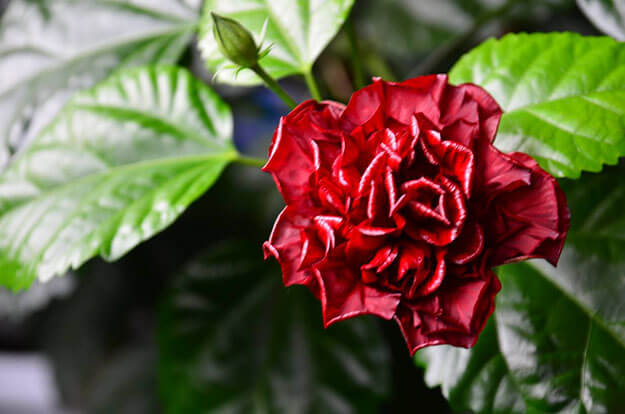
By the way, when transplanting an adult tree into a new container, try not to injure the root system, otherwise it will take root for a long time. It is much easier to simply transfer the plant into a larger container and fill up the prepared substrate. I advise you to do this with a large tree as well - remove the top of the soil and add fresh soil.
Successful pruning rules
- First you need to decide for what purpose the pruning is carried out, and in what way it will be carried out. The formation of flowers in the Chinese rose occurs at the tops of the stems. When pruning branches, the tree begins to bush more and more flowers are formed. The plant is pruned in early spring, hibiscus can be pruned a little in the fall.
- Pruning tools must be clean and very sharp. Poorly sharpened scissors and knives make the cut ragged, worsen the appearance of the plant, and the cut branches will take a long time to heal. Before each trimming procedure, the instruments are not only washed, but also disinfected. It is best to use alcohol for disinfection.
- It is best to prune hibiscus after transplanting, in spring or summer. After the procedures, the care for the rose remains the same.
- Even before you start trimming, you need to decide which shape is needed. All cuts must be done at an angle of 45 degrees. Caring for the rose immediately after pruning, in order to avoid infection of the Chinese rose and for faster healing of wounds, includes sprinkling all the cuts with crushed charcoal. You can use charcoal or activated charcoal.
- The top of the plant is pruned, stepping back from the place where the last upper branches grow. Secondary shoots are shortened when the plant finishes flowering.
- The main rule for pruning a Chinese rose is that no more than 2/3 of all branches can be cut.
Thanks to these rules, the plant will receive minimal injuries that heal quickly.
How to prune hibiscus
The most popular form of hibiscus, which has a very effective appearance, is the stem.
It is not so easy to form it at home, and after the plant takes on the desired shape, regular care is required for the branches to maintain the standard shape of the crown. But if you follow the instructions, you can get an amazing Chinese rose stem tree.
- To obtain a standard form, a young hibiscus is chosen. Its central shoot must be straight. Then this shoot is tied to a reliable support at the same distance and is not removed until the trunk becomes strong and stable. The growing side shoots are periodically removed.
- When the plant reaches the required height, pinch the top of the plant. This is done to stimulate the growth of side shoots.
- After removing the top, the hibiscus will begin to actively branch. Therefore, the side branches are shortened and pinched monthly. This measure will promote the growth of dormant buds and the growth of new shoots.
- All lower shoots continue to be removed, and the upper ones are not touched. Over time, the plant will acquire the desired spherical shape.
To maintain a neat decorative shape at home, careful care is required. The hibiscus is periodically trimmed, not allowing the crown to grow. A haircut is done once a year in the fall months. If you do this at a different time, then the hibiscus will not bloom.
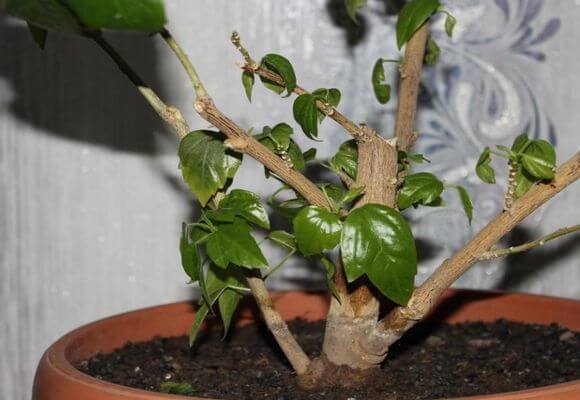
You can try to grow a bonsai-style tree from hibiscus. But the formation of a Chinese rose for such a purpose, the plant is very difficult and time consuming. Professional florists can receive beautiful trees decorated with many flowers.
Such plants will look very impressive and unusual in the interior. The main problem with bonsai formation is that the hibiscus twigs quickly become thick and woody.
To form a bonsai, you need to take a young plant. Its branches are tied to supports and tensioners.
Their growth must be guided very carefully; this can be done with the help of a wire
When a young plant begins to form, this can affect flowering, but for the sake of a beautiful well-groomed shape, it is worth waiting for the flowers to appear. In trees that are already formed in the bonsai style, the shoots are shortened after flowering.
Chinese roses quite steadfastly endure the procedure of pruning shoots and shaping, so special care for them after the work done is not needed. All fertilizing and watering is done as usual.
Do not be afraid to radically cut and thin out the hibiscus, but on the contrary, getting rid of old and unnecessary branches, the plant receives more nutrition for the formation of flowers and the growth of new strong shoots. The correct formation of the crown of the plant will make the hibiscus the main decoration of the house or greenhouse.
Chinese rose pruning procedure
Before carrying out the trimming procedure, you need to decide on the final result that you would like to get (size and shape). At the request of the owner, a small tree can be made from hibiscus, and a sprawling flowering shrub, which is easily placed on the windowsill. To form a tree, lateral shoots are removed from the second generation. At the same time, several central shoots are left. The upper part is neatly shortened into several buds. This will form the future crown of your tree.

Crown formation
To form a shrub, the central branch of the rose is cut on the contrary, which allows the lateral processes to gradually develop into full-fledged stems. Several lower buds are retained, and the central part is removed.
The plant tolerates the pruning procedure very well, so you can safely carry out experiments and embody your most interesting design ideas. There were cases when the ground part of the plant practically died, and the rose revived from underground buds.

After you have designed the upper crown of the plant, then in the future the process of pruning a Chinese rose will consist of the gradual removal of branches that grow parallel to the central trunk and into the depth of the crown of the plant. If they are not trimmed, then this will interfere with the formation of a beautiful appearance. They also require additional nutrition and strength of the plant in the process of its development.
Later, when shoots of the third and subsequent generations appear, the Chinese rose is shortened by several buds. This procedure promotes the development of a larger number of young shoots, on which a significant number of new buds will form.
Pruning
It is important to prune the Chinese rose correctly after the end of the flowering period. Often this procedure is carried out in the fall or early spring - until the plant begins to actively develop
If you do this in late spring, then the hibiscus may not bloom at all in the summer.
They carry out the pruning procedure with scissors, since the branches of the plant are too thin for a special garden tool.

It is very useful for a spring transplant or soil replacement to cut off all branches to a length of fifteen centimeters from the root. In this case, a few centimeters are left from the buds and leaves. The upper part must also be trimmed to the place where the last branches grow from the main trunk. When new processes are formed, the weakest are simply removed.
If the indoor hibiscus has never been pruned before, then such a cardinal procedure will only benefit him.
Follow-up care
After completing all the manipulations, the Chinese Rose can be sprayed with Epin for easier adaptation. And then we take care of it as usual, we provide the conditions necessary for its successful growth and flowering.
- Watering - when active growth or flowering occurs, then abundant watering is needed so that the soil does not dry out, the top layer only slightly dries out. In cool weather (autumn - winter), watering is not needed so often, but the soil in any case should not dry out, water it about once a week. Only soft, settled water is suitable for irrigation.
- Humidity - you need to maintain an air humidity of about 45 - 50%, for this you can put a fountain next to the bush or just a vase of water. It is also necessary to constantly spray the plant, only with soft and warm water, periodically rinse it under the shower, the leaves must be clean from dust.
- Top dressing - it is very good to use complex, such as "Rainbow", you need to apply approximately once a month, and during flowering 2 times a month.
- Temperature - in summer the desired temperature for a plant is 20 - 25 degrees, and in winter it is necessary to maintain about 18 - 16 degrees. The Chinese Rose does not like drafts, it is necessary to ventilate the room, an influx of fresh air is required for the flower, but exclude the ingress of wind (especially cold).
- Lighting - you need good, better on the east window (or west), the light should be diffused, shade from the direct rays of the sun. In the summer, it is very useful to take the flower out to the balcony, in the fresh air.
We watch a video on the topic: "Caring for a Chinese rose at home"
You can find out more about caring for a Chinese rose here.
Care features
To achieve success in growing a crop, it is necessary to water it in a timely manner, carry out pruning, and apply fertilizers.
Watering mode
During the active growth of the culture, it needs to be watered quite often. It should be borne in mind that the soil should not dry out. Drying of the topsoil by 3 centimeters is permissible. The irrigation regime is selected taking into account the temperature indicators. In the summer, it should be done every other day. In the fall, the frequency of watering is reduced. In winter, 1 watering per week is enough.
Temperature and illumination
Adequate lighting is required for the normal development of culture. To ensure the normal formation of the kidneys, the sun's rays are needed. High-quality lighting will guarantee a long and abundant flowering.
The optimum temperature for hibiscus is +26 degrees. In winter, it is recommended to reduce this indicator to +18 degrees. At low temperatures, the kidneys form better. If the temperature is high in winter, you should not expect a lush bloom.

Ambient humidity
The culture needs high humidity. Therefore, it is recommended to spray the foliage with water in winter and summer. It is also permissible to use a container with wet pebbles. In this case, it is recommended to install the pot in such a way that its bottom does not come into contact with water. Sometimes the plant needs a warm shower. This procedure helps to hydrate foliage and fight spider mites.
Spraying
In spring and summer, hibiscus should be sprayed at intervals of 2-3 days. It is recommended to perform this procedure every day in hot weather. In this case, it is allowed to use exclusively settled water.
Transfer
The Chinese rose is growing rapidly. Therefore, it is recommended to replant young bushes annually.It is recommended to do this in spring or summer. Adult crops can be transplanted every 4 years. At the same time, they should change the topsoil to a fresh one every year.
To transplant a culture, it is recommended to place a drain on the bottom of the container. For this purpose, it is permissible to use expanded clay or small pebbles. The flower is planted in the center of the pot. Then you should carefully add soil and water the plant.
Fertilization and feeding
Experts say that such plants are best fed with liquid fertilizers.
At the same time, it is important to choose the right composition of them.

Nitrogen
It is recommended to fertilize the rose with such means using a foliar method. To do this, take 1 gram of urea and mix with 1 liter of water. After that, it is recommended to spray the culture with a spray bottle.
Potash
Such funds are recommended for use in the spring, when the active development of culture begins. Potassium is responsible for bud formation. The plant needs phosphorus to ensure normal root development. Therefore, experienced flower growers recommend using potassium-phosphorus products.
Complex mineral fertilizers
In summer, it is advisable to use complex mineral preparations. It should be borne in mind that it is recommended to feed the bushes in the evening. Before carrying out the procedure, the rose should be watered.
Pruning and shaping the bush
Hibiscus pruning is done in the spring. This is done shortly before the transplant. At the same time, there should be no flowers or buds on the bush. Pruning stimulates the flowering of the culture and the formation of a large number of flowering branches. At the same time, the bush itself becomes thicker and more beautiful.
During the procedure, it is worth cutting off the elongated, dry and bare branches. It is recommended to shorten the rest of the shoots by half. Places of cuts should be treated with garden varnish. At the same time, juice should not flow from them. Cut shoots will make good cuttings. You can get new bushes from them.
To rejuvenate an adult plant, all shoots are pruned at a height of 15 centimeters
In this case, it is important to ensure that at least 1 bud remains on each branch. As young shoots develop actively, it is recommended to get rid of weakened branches.
In this case, strong and healthy shoots should remain. In the summer, the bushes should be pruned again. At the same time, the formation of flower buds on the regrown shoots will occur only in September. But the abundant flowering will last until spring.

Growing problems
If you notice the symptoms of the disease in time, you can quickly determine the cause and correct the situation. Now we will describe what this or that symptom means.
Hibiscus sheds unblown buds.
- insufficient watering;
- low room temperature;
- lack of nutrients.
Leaves wither.
- insufficient watering;
- excessive watering, and, as a result, decay of the root system.
Leaves dry and curl.
insufficient air humidity.
Leaf fall.
- the presence of pests;
- the flower stands in a draft.
The leaves turn yellow and dry.
- watering is done with hard, most likely not settled chlorinated water;
- low room temperature.
The stems are elongated, the leaves lose their bright color, turn pale.
lack of sunlight.
Indoor hibiscus does not bloom.
- too large a pot;
- insufficient lighting;
- lack of fertilizing;
- not trimmed.
There are sticky droplets on the back of the leaves.
- insect pests;
- the norm for some odorless varieties. This is how they attract insects for pollination.
On the obverse of the leaves there is a white bloom, which turns brown over time.
Powdery mildew. Remove infected leaves. Treat the hibiscus with Bayleton or Fundazol.
Pinkish spots on the leaves.
- excess fertilizer;
- lack of light.
Pests
Spider mite.
On the leaves there are yellowish spots, a small cobweb is noticeable. Spray the Chinese rose with insecticides such as Fitoverm or Derris.Avoid excessive dryness of the air, regularly spray the plant with water from a spray bottle. If spraying does not help, place the flower under an ultraviolet lamp.
Shield.
Hard brown growths are observed on the back of the leaves along the veins. Adult scale insects are not afraid of chemicals and will have to be removed by hand. Then spray the plant with the insecticide solution. Repeat the procedure several times until you completely get rid of the scabbard.
Aphid.
Young leaves and shoots wither and curl. Small insects are visible on them. Spray the plant with aphid remedy according to the instructions.
Care after haircut
After the cutting procedure, the hibiscus needs to create optimal conditions.
Watering
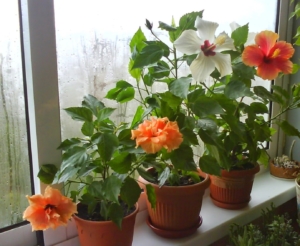
Even in winter, watering the rose cannot be stopped.
Hibiscus does not like air that is too dry. To make it humid, you can put a container of water in the room.
Rose leaves should be periodically washed in the shower to remove accumulated dust. During the period of active growth of the flower, the air temperature in the room should be at least 20 degrees, and in winter at least 16 degrees.
A container with a flower is best placed in a room with windows that face west or east. If the room is strongly sanctified by the sun, then it is better to shade the flower from direct rays. In the summer, you can take the plant outside.
Top dressing
Fertilizers for a Chinese rose can be made independently from improvised means - shells or tea bags. But it's better to use proven methods and buy more nutritious products like mullein, mineral mixes, chicken droppings.
Organic substances include: wood ash, bone meal, compost, humus. In order not to burn the roots of hibiscus, chicken manure and mullein must first be diluted with water. It is necessary to carry out such events in the country.
Infusions contain potassium and nitrogen. But for phosphorus nutrition, it is better to use other substances (bone meal or wood ash).
If you immediately add soil and ash to the soil, then they neutralize each other's action and become useless.
Mineral fertilizer for hibiscus should include phosphorus and potassium. If the flower asks for an additive, which will be visible on the leaves (they will become lethargic), then you can spray it with a urea solution. If the flowers come to life, then it means he needs nitrogen and it is worth re-spraying it.
Shelter for the winter

- The bush is bent to the ground and covered with plastic wrap or other non-woven material.
- The rose is fenced with a frame and insulated with material.
Tree-like rose varieties do not withstand severe frosts below eighteen degrees. Gardeners use the following methods on the plots:
- Cover with spruce branches or stems of other plants.
- A wooden frame fence is installed and covered with non-woven insulation.
Lapnik is laid near the bush in several layers. Snow will fall and reliably cover the plant from frost.
The hibiscus is covered by other plants in an upright position. Above and below the material is tied with a bundle. It turns out a sheaf that will help save the rose from the cold.
The second method is to install a frame made of bars. The frame is covered with several layers of non-woven insulation. When spring comes and the frost is gone, the bush will need to be freed from the insulation.
Hibiscus is an evergreen with vibrant foliage. Even without flowers, it retains its decorative effect. If you follow all the rules for caring for him, then you can enjoy luxurious flowering for several months in a row.
Indoor hibiscus
The hibiscus plant was well known in ancient Greece. However, then this name was called mallow. The hibiscus is known today as the Chinese rose. The plant is loved and revered on many islands in the Pacific Ocean. For local women, hibiscus inflorescences are an exquisite hair ornament.Apparently, this tradition gave the name to the plant, as in translation "hibiscus" means "a flower for beautiful ladies."
The Malaysians revere hibiscus as a national flower, each petal of the inflorescence symbolizes the commandment of Islam. The residents of India and China respect this handsome man. This plant is credited with wonderful properties - the inhabitants of the East believe that hibiscus protects the hearth from evil intentions, helps business people to succeed, and also gives strength to cope with depression.
Reproduction of indoor hibiscus

Indoor hibiscus propagates both by seeds and cuttings. However, there is too much trouble with seeds for a novice grower - this method is quite laborious and is more suitable for those who are engaged in the selection of indoor hibiscus. And propagation by cuttings has several indisputable advantages. Firstly, this method retains all the varietal characteristics inherent in the mother plant.
And secondly (which is especially important for an amateur grower), with this method, the plant begins to bloom in the first year
Seed propagation
Seeds are best sown from late January to mid-March. Before planting seeds in the ground, they should be soaked for 12 hours in Epin. You need to plant seeds in a mixture of peat and sand. After planting, the pot is covered with glass or foil to create greenhouse conditions. It is necessary to constantly maintain the temperature within 25-27 degrees. Also, do not forget to periodically ventilate the pot and spray the soil with seeds.
When young sprouts have 2-3 leaves, they can be transplanted into a separate pot. Hibiscus grown from seed will only flower for 2-3 years.
Propagation by cuttings
Young cuttings are best suited for propagation. Place them in water or soil to root. In the first case, you will need a vessel, preferably made of dark glass, filled with water. Place a stalk in it and cover with a "cap" - for example, a glass jar. This is necessary to increase the moisture content. Cuttings will take root in about 25-30 days. When the roots appear, the cutting will need to be transplanted into an earthen mixture containing a large amount of peat. It is advisable to add sphagnum moss there - this is especially useful for a young plant.
When rooting directly into the soil, you need a mixture of coarse sand and peat. But do not forget that before this, all leaves must be removed from the cutting, except for the top two.
Planting and breeding hibiscus
Growing hibiscus by seed method is a troublesome and rather difficult task. If the planting material was purchased from a garden store, then germination rates are minimized. Best of all, only those flower seeds that have been obtained from "predecessors" can germinate. In order to get healthy seedlings, you need:
- Prepare the soil, fill the planting container with a mixture of sand and peat.
- Sow flower seeds in holes, the depth of which should be no more than 1 cm, after which the soil should be well moistened. The sowing must be covered using a plastic bag or glass. Place the container with a flower in a warm place, making sure that the temperature there is at least +25 degrees.
- After the third true leaf appears, the seedlings need to be transplanted into separate pots.
When hibiscus is planted by seed, its flowering begins after a year, in most cases - two years.

Hibiscus transplant
With regard to propagation by apical cuttings, this method is quick and simple. In order for the hibiscus to take root successfully, it is recommended to use cuttings that were obtained during the process of pruning the plant. The length of the cut cuttings should be no more than 8 cm, and the sections that have been cut must be treated with a substance that promotes the formation of roots (Kornevin).To root the apical cuttings at home, they must be placed in a container of water or immediately planted in the ground. If you choose the latter method, you need to take a jar or other container and cover the pots with seedlings with it.
Important! After the first signs of growth appear, the shelter will need to be removed. Roots often develop within 30 days, and after 120 days, the first buds can be seen blooming.
How to transplant hibiscus at home step by step
The first step before planting is to properly form the soil for the hibiscus. In such a situation, flower growers have two solutions: buying ready-made soil intended for growing a Chinese rose or preparing a potting mixture on their own at home. To do this, you need to take clay turf - 2 parts, mix it with leaf humus, earth from a site near the garden, charcoal and vermiculite.
Mix these components thoroughly. You need to plant variegated hibiscus in containers that are 3 cm deeper than the previous ones. The transplanting process is carried out with the onset of spring.
Carefully remove the hibiscus from the container; in the presence of dark old roots, be sure to remove them with sharp scissors or another sharp sterile object. The places where the roots were cut off, treat with charcoal
Further, the root system of the flower is placed in a pot closer to the drainage layer. This will help protect the roots from the high moisture content of the soil. The drainage layer, consisting of broken brick or large pebbles, should occupy at least 1/3 of the pot's volume.

Hibiscus care
Next, carefully position the plant, gradually removing or adding soil to achieve the desired position of the hibiscus in the new pot. Spread the earth evenly, filling all the remaining space. In this case, the root collar of the flower should remain at ground level.
Place the flower pot in a special tray and pour abundantly with warm water. Wait until the excess water is gone, then remove the pan. If the soil has settled a little as a result of watering, it needs to be filled up.
What harmful insects and ailments should be feared?
The Chinese rose is an indoor flower that can infect spider mites, thrips or aphids. Insect infestation occurs when the requirements for care are violated. The problem often arises when the air in the room is dry. Spraying the foliage of a Chinese rose with a spray bottle will help prevent it. The water should be at room temperature and settled. You also need to pour small pebbles (gravel, crushed stone) into the pallet and moisten them well with water.
With a frequency of 1 every 2 weeks, the flower is sprayed with an infusion of bitter pepper mixed with soap. Such a composition perfectly fights against uninvited guests on flowering shrubs.
If the culture is highly infected, it is treated with Actellik's solution every 14 days, which is prepared by diluting 15 drops of the composition in a liter of water.
Some growers have to deal with yellowing of the leaves of Chinese roses. The problem is caused by a disease called chlorosis, which occurs due to an excess of chlorine and calcium in the water used for irrigation. Preventing the development of chlorosis will help preliminary settling of water before watering the flower. Iron chelate is also added to the water in the dosage recommended by the instructions.
Pruning a home flower
How can a home flower be pruned? Depending on the age of the plant, its condition and the expected shape of the crown, there are 5 types of pruning:
- Pinching is suitable for young plants.
- This is the most gentle type of pruning.
- It is used to stimulate growth.
- It consists in removing the tops of all branches above the top node.
-
You need to pinch when the plant is about 13 - 15 cm high.
- To strengthen the trunk when pinching, the central shoot is attached to the base (for example, to a bamboo skewer).
-
Selective pruning is done not only to stimulate growth, but also to maintain the shape of the plant. This type of pruning is a more thorough pruning of branches: several already well-developed internodes are cut off. Certain areas are cut off that violate the shape of the crown.
The sequence of this type of hibiscus pruning is as follows:
- Cut off lateral shoots, leaving up to 4 - 5 leaves.
- Make a cut just above the node, leaving at least 2/3 of the branch.
- Branches growing parallel to the central trunk and inside the crown must also be pruned.
-
Pruning over the growth point that faces outward.
Reference: the cut is made at an angle of 45 degrees.
- Full pruning ensures abundant flowering of the plant. Produced in early spring for abundant flowering. With full pruning, each branch is shortened to two or three buds.
- Sanitary pruning is the removal of disease-damaged areas of the plant. The cut is made before the appearance of living wood. If the cut is green, then the branch is alive. The brown and white cut of the branch requires immediate pruning.
Do not try to leave as many shoots as possible when pruning. Don't be afraid to trim! Even if you cut off the excess, the plant will survive. Pruning tools must be sharp and disinfected.
What is hibiscus pruning for?
Pruning is a vital procedure for hibiscus for many reasons:
- Relieves the plant from deformed branches. With growth, hibiscus has underdeveloped and twisted shoots. If you remove them in time, then full-fledged shoots will appear at this place.
- Gives the bush the desired shape. Indoor hibiscus growing without proper care cannot please you with a rich crown. The plant will give all its strength to the old and weak growth, flowering will become scarce, and over time it will disappear altogether.
- Rejuvenation. With age, the plant forms many dead branches, pruning allows you to remove excess and rejuvenate the plant, giving it a good push.
- Removal of diseased branches. Regular and timely reorganization will save the plant from branches damaged by diseases and pests. This pruning will prevent the spread of the disease to healthy shoots.
- Root pruning. This event is held only in cases when the roots of the Chinese rose have grown strongly, and it is cramped in the container. Root pruning produces good growth and lush flowering.

How to transplant hibiscus

The first transplant of indoor hibiscus must be carried out a couple of weeks after purchase. Stores use a depleted substrate so that the plant does not grow too much while on the counter. But if you bought a flowering specimen, wait until the flowering ends, otherwise all the flowers will fall off. Further, young specimens less than 3 years old are transplanted once a year in early spring, slightly increasing the diameter of the pot. Older specimens are transplanted every 2-3 years, and adult large bushes are no longer transplanted at all. It is enough to renew the topsoil.
Pot
Each time, the new pot should be slightly larger than the previous one. But you cannot immediately take too large a container, otherwise the plant will put all its strength into the growth of roots and foliage, leaving you without colorful flowering this year. The diameter of the pot should be increased until it reaches 30-40 cm. In the future, new pots are not used, and the transplant can be carried out in the same pot. Otherwise, you will grow a rather large bush at home and will face the problem of placing it.
The soil
For indoor hibiscus, loose soil with neutral acidity is suitable. The easiest way is to buy ready-made hibiscus soil in the store. If this is not found, you can prepare the mixture yourself:
- Buy a universal soil for indoor plants and dilute it with an equal part of garden soil with the addition of moss.
- Mix the same universal soil with turf soil and humus in equal proportions. Add some charcoal.
- Mix 2 parts of humus or rotted compost, 1 part of leafy soil, 1 part of sand or vermiculite.
Transplant process
- Stretch out the pot and cooked soil.
- Place a thick layer of drainage and some soil at the bottom of the pot.
- Remove the hibiscus from the old pot along with the earthy clod. Shake off the dirt ball a little, but not completely.
- Examine the roots carefully. If you find rotten roots, cut them off.
- Place the bush in the center of the new pot and sprinkle soil between the earthy ball and the walls. In the process, shake the pot a little so that the earth falls asleep in hard-to-reach places and settles a little. Add some earth and on top, compacting slightly.
- Water and spray well with the hibiscus.
- Return the bush to its old place. The plant does not like moving, and even more so after transplanting it does not need extra stress.
Hibiscus in the house: signs and superstitions

How many contradictions are fraught with such a popular flower as the Chinese Rose or Hibiscus! The possible impact on a person can be different, but to a greater extent superstitions and omens are associated with the imagination of people, and have nothing to do with the real state of affairs. Hibiscus is a flower of death, as many "knowledgeable" people claim, and if flowering occurs at the wrong time, then misfortune will happen to someone close to you. Where this belief came from, no one knows, but many are afraid to keep a luxurious tree with spectacular buds at home, and grow the plant in offices and public places.
There is another opinion - Hibiscus carries powerful energy, tunes in to creativity, activates the circulation of active matter around itself, because the flower belongs to the sign of Fire. The masculine plant restores the flame of love in spouses who have lived for many years in marriage. In many eastern countries, hibiscus is considered a charm of the hearth, a talisman for good luck.
Which version is closer? Decide for each person, taking into account his beliefs and character. If you want to have a Chinese rose, but there are fears associated with bad signs, you can place a flowerpot with Hibiscus at work: a well-groomed, beautiful tree with bright foliage and large flowers will surely delight colleagues and visitors.
Indoor hibiscus is an evergreen plant with spectacular, bright green foliage and luxurious, large buds. Even without flowers, the tree retains its decorative effect. If you follow the rules, you can enjoy the luxurious flowering of the Chinese rose for several months.
More useful recommendations for flower growers about the features of caring for a Chinese rose can be found in the following video:
We propagate a Chinese rose at home
Florists, in whose home greenhouse a Chinese rose grows, culture propagation is performed using seeds or cuttings preserved after pruning the shrub. Cuttings of an ornamental plant, cut in spring, lend themselves better to rooting.
Before rooting, the sections are treated with growth stimulants (Heteroauxin, Kornevin). The Chinese rose, the reproduction of which at the initial stage involves the formation of a good root system, in the form of young cuttings is placed in a container with a peat-sand mixture or water. Cover the rooted seedling with a glass jar on top.
After 3-4 weeks, the stem of the flower will take root well, after which it is transferred to a special soil mixture for the Chinese rose. The seedling must be pinched to activate tillering. In spring, rooted cuttings growing in a well-lit place can even delight the grower with beautiful flowering.
Top cuttings of a Chinese rose with 2-3 internodes, obtained with July or August pruning, are also suitable for propagation.

